
Frantisek Svec - Capillary Electrochromatography
.pdf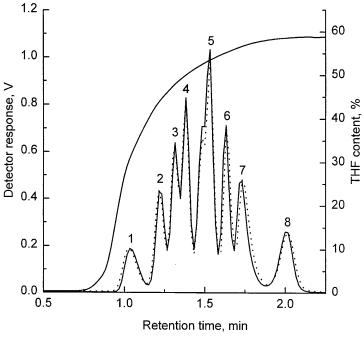
112 |
S. Xie et al. |
Fig. 15. Rapid separation of a mixture of eight polystyrene standards using a monolithic poly(styrene-co-divinylbenzene) column and the corresponding gradient profile monitored by the UV detector (Reprinted with permission from [124]. Copyright 2000 Wiley-VCH). Separation conditions: 1.25 min gradient of THF in methanol consisting of 0–35% THF in methanol in 0.12 min, 35–50% in 0.38 min, 50–55% in 0.25 min, 55–59% in 0.25 min, and 59–60% in 0.25 min, overall sample concentration 16 mg/ml (2 mg/ml of each standard) in THF, ELSD detection. Molecular weights of polystyrene standards: 3000 (1), 7,000 (2), 12,900 (3), 20,650 (4), 50,400 (5), 96,000 (6), 214,500 (7), and 980,000 (8). Dotted line shows the same separation recorded more than two months and about 400 injections later
3.7.4
Chromatography of Midsize Peptides
Short peptide molecules are a very important family of compounds produced by the pharmaceutical industry using both biotechnology and synthetic processes. HPLC is a valuable tool for both monitoring their preparation and achieving their purification. Because of their higher molecular weights, the slower mass transport (diffusion) of the analytes within the pores of typical poly(styrene-co-di- vinylbenzene) beads in a packed column negatively effects the quality of the separation. In contrast, the separation in a molded column with the same styrenic chemistry can be considerably faster, owing to the much better mass transport. For example, the isocratic separation of the peptides bradykinin (Arg-Pro-Pro- Gly-Phe-Ser-Pro-Phe-Arg) and (D-Phe7)-bradykinin, which differ only in their seventh amino acid residue (L-proline and D-phenylalanine, respectively), can be
Porous Polymer Monoliths: An Alternative to Classical Beads |
113 |
achieved in only 3 min. The efficiency of the molded column for peptides with a molecular weight of about 1000 as determined with bradykinin in 50% aqueous acetonitrile is very good, amounting to 7900 plates/m [67]. Even faster separations of five peptides in about 1 min were achieved with a commercially available monolithic reversed phase column [127]. These monolithic columns manufactured by ISCO Inc. feature smaller pores and exhibit resolution similar to that of typical HPLC columns packed with 5-µm C8 silica beads.
Excellent performance for the elution of another peptide, insulin (molecular weight 5800 g/mol), was also observed using silica-based monoliths. The efficiency of the monolithic column was much better than that of a column packed with beads, and did not change much even at high flow rates.
3.7.5
Gradient Elution of Proteins
Gradient elution is a very popular method for the separation of natural macromolecules because the retention of different components of a complex biological mixture may vary considerably. In contrast to isocratic separations, the use of a gradient of mobile phase accelerates the elution, allowing separation of the sample components to be completed within a reasonable period of time. The mechanism of gradient elution is similar for many of the retentive HPLC modes such as reversed-phase, ion-exchange, and hydrophobic interaction chromatography [126]. Typically, the first step is the adsorption of the sample in the separation medium close to the top of a column, followed by successive dissolution of individual components as the composition of the mobile phase is changed. The nature of the components selected for the mobile phase is dictated by the separation mode used.
For example, mixtures of water or a dilute buffer solution and organic solvent such as acetonitrile are typically used for elutions from a highly hydrophobic separation medium in the reversed-phase chromatographic mode. The monolithic media tolerate fast flow rates, thus easily enabling high throughput separations. Figure 16 shows the reversed-phase separation of three proteins in a molded poly(styrene-co-divinylbenzene) rod column at two different flow rates using a constant gradient volume. The individual proteins are baseline separated into sharp and narrow peaks. No significant differences can be seen between separations done over the broad flow rate range of 5–25 ml/min.As expected, the quality of the separation does not change for runs that use the same gradient volume [31]. This, together with the low back pressure observed for the monolithic columns even at very high flow rate, enables rapid separations to be achieved simply with an increase in the flow rate or by using an even steeper gradient [53]. Figure 17 shows the rapid separation of five proteins in less than 17 s using a commercial column [127]. Norbornene-based monoliths were also used for the separation of model proteins using reversed phase chromatography [58]. These monoliths easily tolerate high flow rates of up to 10 ml/min and the good separations achieved even at this high flow rate confirm the existence of fast mass transfer.
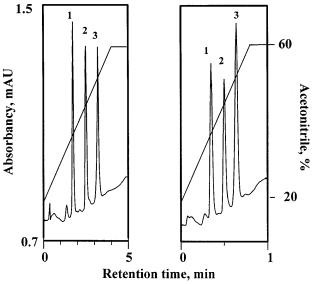
114 |
S. Xie et al. |
Fig. 16. Separation of cytochrome c (1), myoglobin (2), and chicken egg albumin (3) by re- versed-phase chromatography on a monolithic poly(styrene-co-divinylbenzene) column at flow rates of: a 5 ml/min; b 25 ml/min. (Reprinted with permission from [53]. Copyright 1996 American Chemical Society). Conditions: column 50 mm¥8 mm i.d., mobile phase: linear gradient from 20 to 60% acetonitrile in water
The ability to prepare monoliths within a mold of any shape was used by Lee et al. [128] who prepared monolithic ST-DVB microbeads within pulled fused silica needles and used them for the reversed-phase separation and on-line electrospray ionization mass spectrometry (ESI-MS) detection of proteins and peptides. As illustrated by Fig. 18, these monolithic microcolumns separated proteins far better than capillaries packed with commercial C18 silica or polymeric beads.
Huber’s group recently prepared poly(styrene-co-divinylbenzene) monolithic columns in the capillary format using tetrahydrofuran/decanol mixtures as porogen. These columns were tested for the HPLC separation of protein digests followed by ESI MS detection enabling protein identification [129]. This technique represents an important contribution to the currently emerging techniques for studying of proteomes as it is more convenient and accurate to use than the classical 2-D gel electrophoresis.
In contrast to reversed-phase chromatography, the separation in ion exchange mode occurs under mild condition using an entirely aqueous mobile phase. The elution from an ion exchange monolith, which must contain charged ion exchange functionalities, as for any other ion exchange column is achieved using a gradient of increasing salt concentration in the mobile phase. The epoxide groups of a molded poly(glycidyl methacrylate-co-ethylene dimethacrylate) monolith can be readily modified to form ion exchangers [130–132]. For example, the reaction with diethylamine leads to an analog of the diethylaminoethyl (DEAE)

Porous Polymer Monoliths: An Alternative to Classical Beads |
115 |
chemistry (Fig. 6), which is well suited even for large scale separations. Figure 19 shows the ion exchange separation of 20 mg of a protein mixture including myoglobin,conalbumin,and soybean trypsin inhibitor using a relatively large molded 60¥16 mm i.d. diethylamine modified monolith [133]. The proteins are baseline separated and the symmetry of the peaks is very good. Using commercial monolithic columns with a similar chemistry recently developed by ISCO for fast ionexchange chromatography, four proteins were separated in 3 min with an excellent resolution. These columns are also very stable and no changes in recovery
Fig. 17. Rapid reversed-phase separation of proteins at a flow-rate of 10 ml/min (Reprinted with permission from [127]. Copyright 1999 Elsevier). Conditions: Column, 50¥4.6 mm i.d. poly(styrene-co-divinylbenzene) monolith, mobile phase gradient: 42% to 90% acetonitrile in water with 0.15% trifluoroacetic acid in 0.35 min, UV detection at 280 nm. Peaks: ribonuclease (1), cytochrome c (2), bovine serum albumin (3), carbonic anhydrase (4), chicken egg albumin (5)
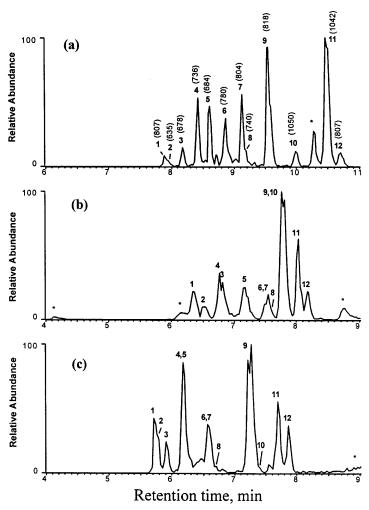
116 |
S. Xie et al. |
Fig. 18 a – c. Base peak chromatograms for the LC/MS analyses of a cytochrome c Lys-C digest (0.7 pmol injected) on: a a poly(styrene-co-divinylbenzene) monolith-filled needle; b Vydac C18-packed needle; c Poros R2-packed needle. (Reprinted with permission from [128]. Copyright 1998 American Chemical Society)
have been found even after several hundreds of runs. This makes them well suited for high throughput separation of biomacromolecules.
In addition to the monolithic DEAE weak anion exchanger, ISCO has also developed several other monolithic columns including a strong anion exchanger as well as weak and strong cation exchangers. It has been demonstrated that, using these monolithic ion exchangers, resolution similar to that of conventional HPLC columns can be achieved. Specific attention has also been paid to the long-term stability of repeatedly used columns. Figure 20 shows the separations of three proteins achieved over a long period of time and a large number of injections.
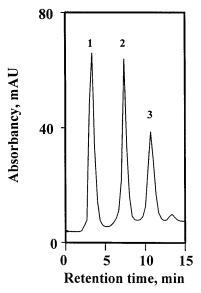
Porous Polymer Monoliths: An Alternative to Classical Beads |
117 |
Fig. 19. Separation of myoglobin (1), conalbumin (2), and soybean trypsin inhibitor (3) by ionexchange chromatography on a diethylamine modified molded poly(glycidyl methacrylate-co- ethylene dimethacrylate) monolithic column. (Reprinted with permission from [133]. Copyright 1995 Wiley-VCH). Conditions: column, monolith 60 mm¥16 mm i.d., mobile phase gradient from 0.01 mol/l TRIS-HCl buffer pH 7.6 to 1 mol/l NaCl in the buffer in 30 min; flow rate 2ml/min; total protein loading 20 mg, UV detection at 280 nm
High performance is in liquid chromatography often synonymous with high pressure since small size particles are packed in the column. Columns packed with larger beads that can be run at medium pressure typically afford relatively poor performance because of the mass transfer resistance within the“long”pores of these large diameter particles. In contrast, monolithic media enable the high performance characteristic of HPLC to be achieved at a medium or even low pressure thus offering the separations in a unique mode that is called “high performance medium pressure liquid chromatography” (HPMPLC).
The breakthrough curves measured for the monolithic columns with different proteins are very sharp and confirm again the fast mass transport kinetics of the monoliths [133, 134]. The frontal analysis used for the determination of the breakthrough profile can also be used for calculation of the dynamic capacity of the column. For example, the capacity for the 60¥16 mm i.d. monolith at 1% breakthrough is 324 mg of ovalbumin and represents the specific capacity of 40.0 mg/g of separation medium or 21.6 mg/ml of column volume.
The ultimate goal in the development of any separation medium, i.e., its use for the separation of “real-life” samples, has also been demonstrated by the separation of baker’s yeast (Saccharomyces cerevisiae) extract. This separation compares favorably to those obtained with commercial packed ion-exchange
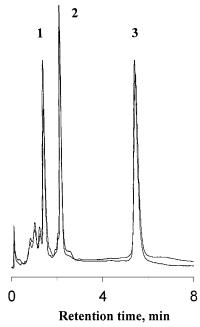
118 |
S. Xie et al. |
Fig. 20. Test of stability of weak cation exchange monolithic column (ISCO). Conditions: column, 50 ¥4.6 mm i.d., mobile phase gradient of sodium chloride in 0.01 mol/l sodium phosphate buffer (pH 7.6) from 0.1 to 0.5 mol/l in 4.5 min and to 1 mol/l in 6.5 min, overall gradient time 11 min, flow rate 10 ml/min. Peaks: Ribonuclease (1), cytochrome c (2), lysozyme (3). The two separations shown in this figure were achieved 503 runs apart
columns, and even to the recently introduced compressed polyacrylamide-based monolithic media (UNO-columns by Bio-Rad) [133].
In order to accelerate further the ion-exchange separations, the rigid porous monoliths were provided with short chains of poly(2-acrylamido-2-methyl-1- propanesulfonic acid) grafted to the pore surface using a cerium(IV)-based redox initiating system [69]. In contrast to the typical chemical modification that occurs within the bulk of the matrix where each epoxide group is transformed into a single charged moiety, the grafting procedure provides chains in which each repeat units bears the required functionality. This increases the local concentration of ion-exchange groups and improves the separation properties of the matrix. Due to the low resistance to flow, elution can be carried out at a flow rate of 7 ml/min, and the separation of proteins is achieved in a linear gradient of the mobile phase within 2.5 min.Although this separation is rather quick, removing the dead volume between the peaks of chymotrypsinogen and lysozyme using nonlinear stepwise gradients accelerates it even more. This simple change in the gradient shape reduces the separation time by more than 30%, and the proteins are baseline separated within only 1.5 min.
A slightly different mechanism of proteins separation results from the use of porous polymeric monoliths containing zwitterionic sulfobetaine groups [68].
Porous Polymer Monoliths: An Alternative to Classical Beads |
119 |
The approach developed by Irgum’s group involves photoinitiated copolymerization of N,N-dimethyl-N-methacryloxyethyl-N-(3-sulfopropyl) ammonium betaine and ethylene dimethacrylate. Alternatively, the internal surface of porous poly(trimethylolpropane trimethacrylate) monoliths were grafted with zwitterionic“combs”by thermally initiated polymerization of the zwitterionic monomer within the pores.While the flow resistance of grafted monoliths was strongly affected by the type of electrolyte,no changes were observed upon variations in the ionic strength of the mobile phase. Since these monoliths interact reversibly with proteins in aqueous solutions they can also be used for bioseparations.
Another gentle method designed for the separation of proteins is hydrophobic interaction chromatography (HIC). The concept of HIC is based on the interactions of surface hydrophobic patches of proteins with hydrophobic ligands interspersed in the hydrophilic surface of the separation medium. The interaction occurs in an environment, such as an aqueous salt solution, that promotes these interactions. The column-bound ligands are typically short alkyl chains or phenyl groups. The strength of the interaction depends on many factors, including the intrinsic hydrophobicity of the protein, the type of ligands, their density, the separation temperature, and the salt concentration. In contrast to ion-exchange chromatography, the separation is achieved by decreasing the salt concentration in the mobile phase, causing the less hydrophobic molecules to elute first.
Since the hydrophobicity of styreneor alkyl methacrylate-based monolithic matrices is too high to make them useful for hydrophobic interaction chromatography, porous monoliths based on highly hydrophilic copolymers of acrylamide and methylenebisacrylamide were developed [70, 135]. The hydrophobicity of the matrix required for the successful separations of proteins is controlled by the addition of butyl methacrylate to the polymerization mixture. The suitability of this rigid hydrophilic monolith for the separation of protein mixtures is demonstrated in Fig. 21, which shows the rapid separation of five proteins in less than 3 min using a steeply decreasing concentration gradient of ammonium sulfate.
Typically, proteins are eluted consecutively in hydrophobic interaction chromatography by applying a decreasing gradient of salt concentration. However in order to operate satisfactorily, a typical HIC column must be re-equilibrated in the initial mobile phase prior to the next run. This decreases the number of runs that can be performed within a given amount of time, and thus represents a serious limitation for high throughput processes. Therefore, a new concept of hydrophobic interaction chromatography has been developed which employs thermally induced change in the surface polarity of the grafted composites to achieve the HIC separation of proteins in a simple isocratic mode [76].
The preparation of monoliths with polyNIPAAm chains grafted to the internal pore surface was discussed previously. The extended solvated polyNIPAAmchains that are present below the lower critical solution temperature of this particular polymer are more hydrophilic, while the collapsed chains that prevail above the lower critical solution temperature are more hydrophobic. In contrast to isothermal separations in which the surface polarity remains constant throughout the run [136], HIC separation of proteins can be achieved at constant salt concentrations (isocratically) while utilizing the hydrophobic-hydrophilic
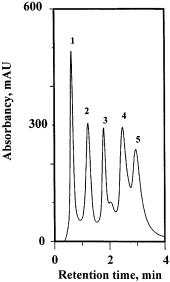
120 |
S. Xie et al. |
Fig. 21. Separation of cytochrome (peak 1), ribonuclease, (peak 2), carbonic anhydrase (peak 3), lysozyme (peak 4), and chymotrypsinogen (peak 5) by hydrophobic interaction chromatography on a molded poly(acrylamide-co-butylmethacrylate-co-N,N′-methylenebisacry- lamide) monolithic column. (Reprinted with permission from [135]. Copyright 1998 Elsevier). Conditions: column, 50 ¥8 mm i.d., 10% butyl methacrylate, mobile phase gradient from 1.5 to 0.1 mol/l ammonium sulfate in 0.01 mol/l sodium phosphate buffer (pH 7) in 3 min, gradient time 3.3 min, flow rate 3 ml/min
transition of the grafted chains of polyNIPAAm, which occurs in response to changes in temperature. For example, carbonic anhydrase and soybean trypsin inhibitor were easily separated. First, the grafted monolith is heated to 40 °C, and a mixture of the two proteins is injected. The more hydrophilic carbonic anhydrase is not retained under these conditions, and elutes from the column. In contrast, the more hydrophobic trypsin inhibitor does not elute even after 10 min. However, the elution occurs almost immediately once the temperature of the column is lowered to 25 °C [76].
3.7.6
Separation of Nucleic Acids
To prepare a suitable medium for the ion-exchange chromatography of nucleic acids poly(glycidyl methacrylate-co-ethylene dimethacrylate) monolithic columns were modified to different extents by reaction with diethylamine to afford 1-N,N-diethylamino-2-hydroxypropyl functionalities. The performance of the resulting stationary phases was demonstrated in the separation of a homologous series of oligodeoxyadenylic (pd(A)12 – 18) and oligothymidylic acids (d(pT)12 – 24) at different flow rates.Very good separations of the oligonucleotides were achieved even at the high flow rate of 4 ml/min [137].
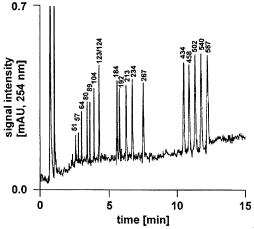
Porous Polymer Monoliths: An Alternative to Classical Beads |
121 |
Fig. 22. High-resolution capillary ion-pair reversed-phase high-performance liquid chromatography separation of a mixture of double-stranded DNA fragments in a 60 ¥0.20 mm i.d. monolithic poly(styrene-co-divinylbenzene) capillary column (Reprinted with permission from [138]. Copyright 2000 American Chemical Society). Mobile phase (A) 100 mmol/l triethylammonium acetate,pH 7.0,(B) 20% acetonitrile in 100 mmol/l triethylammonium acetate, pH 7.0, linear gradient 35–75% B in 3.0 min, 75–95% B in 12.0 min, flow-rate, 2.2 ml/min, temperature 50 °C, UV detection at 254 nm, sample pBR322 DNA-Hae III digest, 1.81 fmol of each fragment
Huber at al. prepared monolithic capillary columns by copolymerization of styrene and divinylbenzene inside a 200 mm i.d. fused silica capillary using a mixture of tetrahydrofuran and decanol as porogen.With gradients of acetonitrile in 100 mmol/l triethylammonium acetate, these monolithic columns allowed the rapid and highly efficient separation of single-stranded oligodeoxynucleotides and double-stranded DNA fragments by ion-pair reversed-phase high-perfor- mance liquid chromatography (IP-RP-HPLC) [138, 139]. These authors also compared the performance of monolithic columns with that of micropellicular, octadecylated poly(styrene/divinylbenzene) beads and found a considerably better performance for the monolithic columns. The use of this type of column enabled the analysis of an 18-mer oligodeoxynucleotide with an efficiency of more than 190,000 plates/m. An ESI MS was on-line-coupled to the chromatographic system to achieve detection of femtomole amounts of 3-mer to 80-mer oligodeoxynucleotides. Similarly, double-stranded DNA fragments ranging in size from 51 to 587 base pairs could also be separated as demonstrated in Fig. 22. This method also allowed the sequencing of short oligodeoxynucleotides.
4 Conclusion
Although much remains to be done in the study of macroporous monoliths, recent achievements open new vistas for the preparation of supports and separation media with exactly tailored properties. The experimental work done so far
